Key takeaways:
- Eco education connects children with nature, fostering curiosity and responsibility for the environment through hands-on experiences.
- Engaging children in sustainability initiatives empowers them to become ambassadors for eco-friendly behaviors and inspires lasting change in their communities.
- Collaborations with local organizations enhance eco education by providing immersive learning opportunities and fostering community pride.
- Success in eco education is measured by changes in children’s attitudes, emotional engagement, and their long-term commitment to environmental stewardship.

Understanding eco education concepts
Understanding eco education concepts is all about connecting children with the natural world. I remember a time when I took a group of young kids on a nature walk, and their eyes lit up as they discovered worms in the soil. This simple experience sparked their curiosity and led to discussions about ecosystems and the importance of every creature in our environment. How often do we really stop to appreciate the foundational role of these tiny beings?
When we delve into eco education, it’s essential to frame it within the context of sustainability. I’ve noticed that kids grasp the idea of sustainability better when I relate it to their daily lives—like the impact of recycling on their local community. They often ask, “What happens to the plastic we throw away?” This question opens up conversations that inspire them to think critically about their choices.
Exploring concepts like biodiversity and conservation can also be incredibly impactful. I once shared stories about endangered species with children, letting them feel a sense of urgency and responsibility. Watching their faces shift from confusion to determination was a powerful reminder that eco education isn’t just about knowledge; it’s about awakening a passion for the planet. After all, how can we expect the next generation to protect our Earth if they don’t understand what’s at stake?
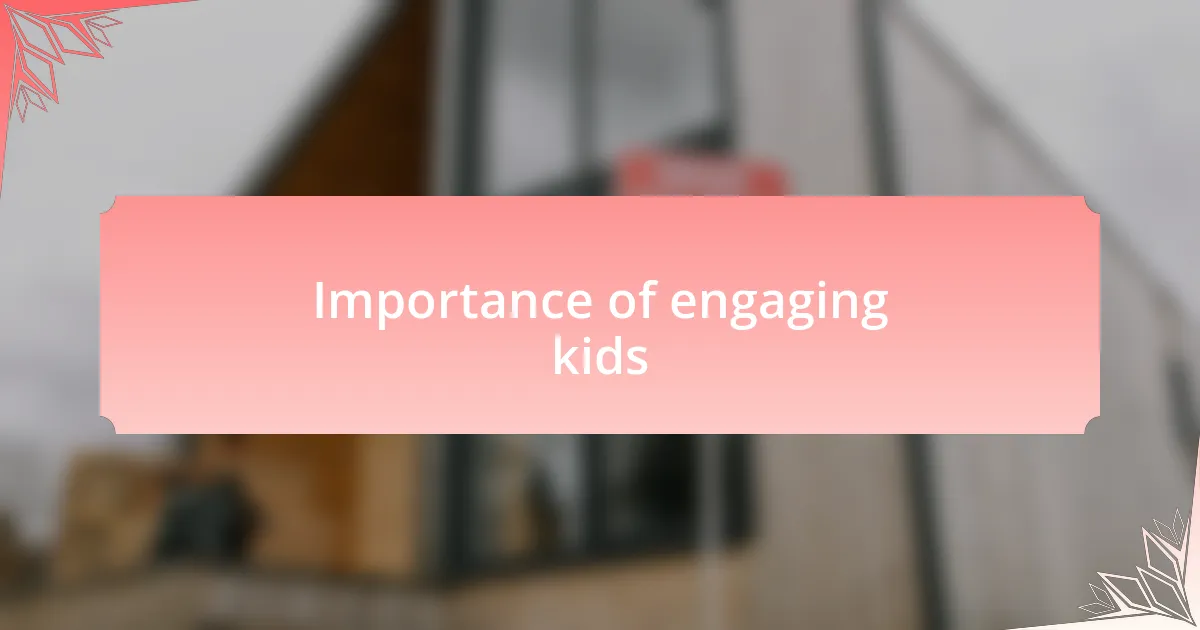
Importance of engaging kids
Engaging kids in eco education is crucial because it helps to cultivate a sense of responsibility toward the environment. I recall a classroom project where we transformed plastic bottles into planters for herbs. The excitement in their voices when they saw their creations sprout was palpable. It dawned on me that through active participation, they began to recognize their role in supporting sustainable practices. Isn’t that a powerful way to instill lifelong habits?
Moreover, when children are involved, they become ambassadors for eco-friendly behaviors. One day, after teaching a group about reducing waste, two kids decided to create a poster campaign in our community. Their enthusiasm was contagious, inspiring not just their peers but also their families to rethink their habits. It made me think: how often do we underestimate the influence children hold in teaching adults about sustainability?
Finally, the emotional connection kids develop with nature through engaging activities fosters a deep care for our planet. I remember a young girl tearfully sharing her thoughts about the impact of pollution during a discussion. Witnessing her empathy reinforced my belief that these feelings can drive change. If kids can express their concern and passion, isn’t it our duty to nurture that spirit?
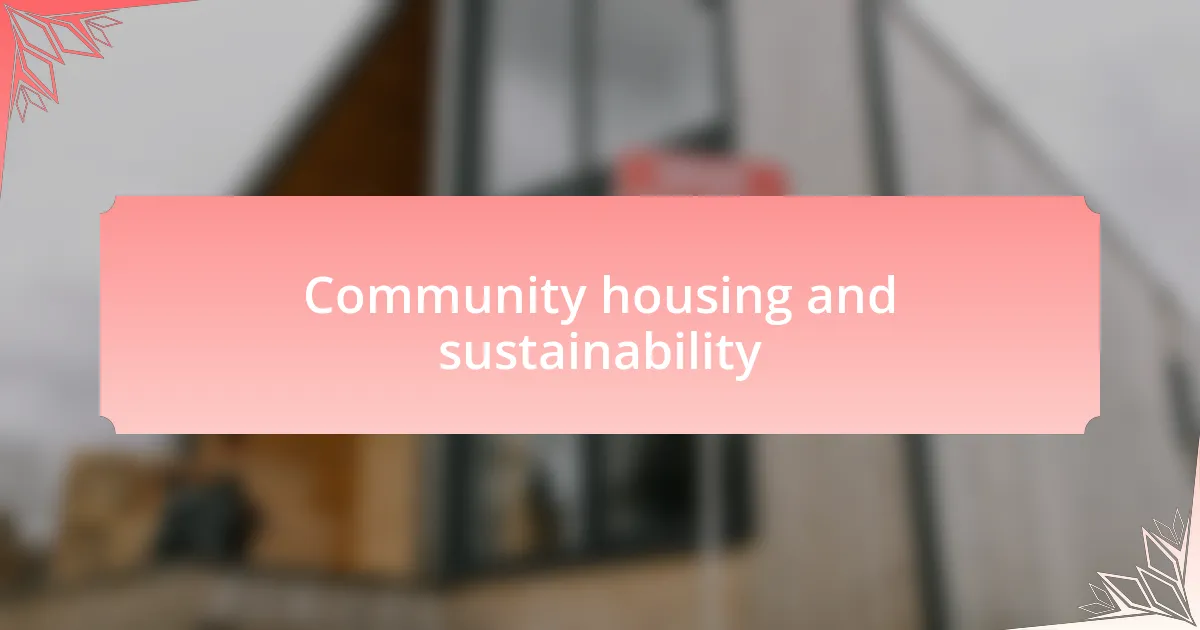
Community housing and sustainability
In the realm of community housing, sustainability plays a vital role in enhancing the quality of life for residents. I recall a neighborhood initiative where we installed community gardens that thrived on rainwater harvesting. Watching families work together to cultivate fresh vegetables not only strengthened community ties but also empowered residents to embrace sustainable practices in their daily lives. Isn’t it fascinating how simple actions can lead to lasting impacts?
The design of community housing can also reflect sustainable principles, such as energy-efficient buildings and shared resources like solar panels. I remember visiting a project where homes were built with eco-friendly materials, reducing their carbon footprint significantly. Residents shared stories about lower utility bills and the satisfaction of contributing to a greener planet. Doesn’t this highlight the potential of community housing to model sustainable living?
Moreover, engaging families in sustainability initiatives can spark a cultural shift toward eco-consciousness. I once joined a workshop where parents and children crafted DIY recycling bins for their homes. The joy on their faces as they realized they were taking tangible steps to reduce waste was infectious. How can we not encourage such transformative experiences that reshape our communities for the better?
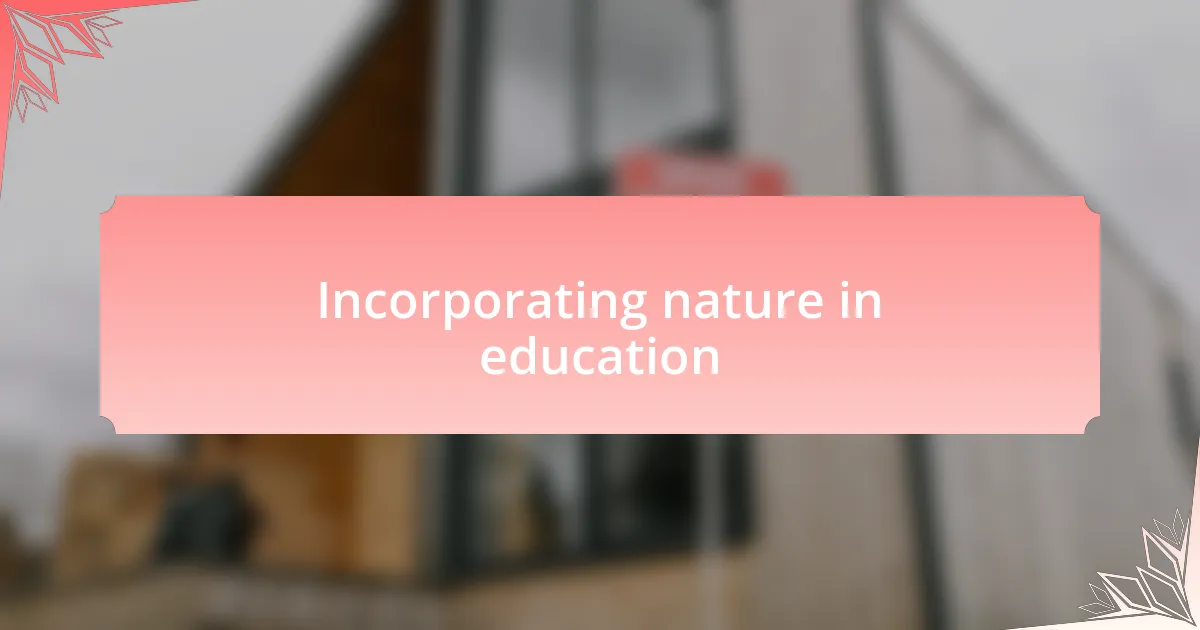
Incorporating nature in education
Incorporating nature into education can create a dynamic learning environment. I once took a group of children on a nature walk, where we not only observed different plant species but also discussed their roles in the ecosystem. Their eyes widened with curiosity as they discovered how interconnected everything is. Isn’t it amazing how direct experiences can ignite a passion for learning?
I’ve also seen how outdoor classrooms transform traditional lessons. When teaching about the water cycle, we conducted simple experiments using rainwater gathered from our garden. The kids were thrilled to see evaporation firsthand—an experience that chalk-and-board methods just can’t replicate. How often do we overlook nature as an essential teaching tool in our quest for effective education?
Additionally, integrating nature into the curriculum fosters a sense of stewardship in young minds. I facilitated a project where students researched local wildlife and engaged in habitat restoration within their community. Their pride in making a tangible difference was palpable, reminding me how powerful hands-on learning can be. Could this be the key to nurturing future generations of eco-conscious leaders?
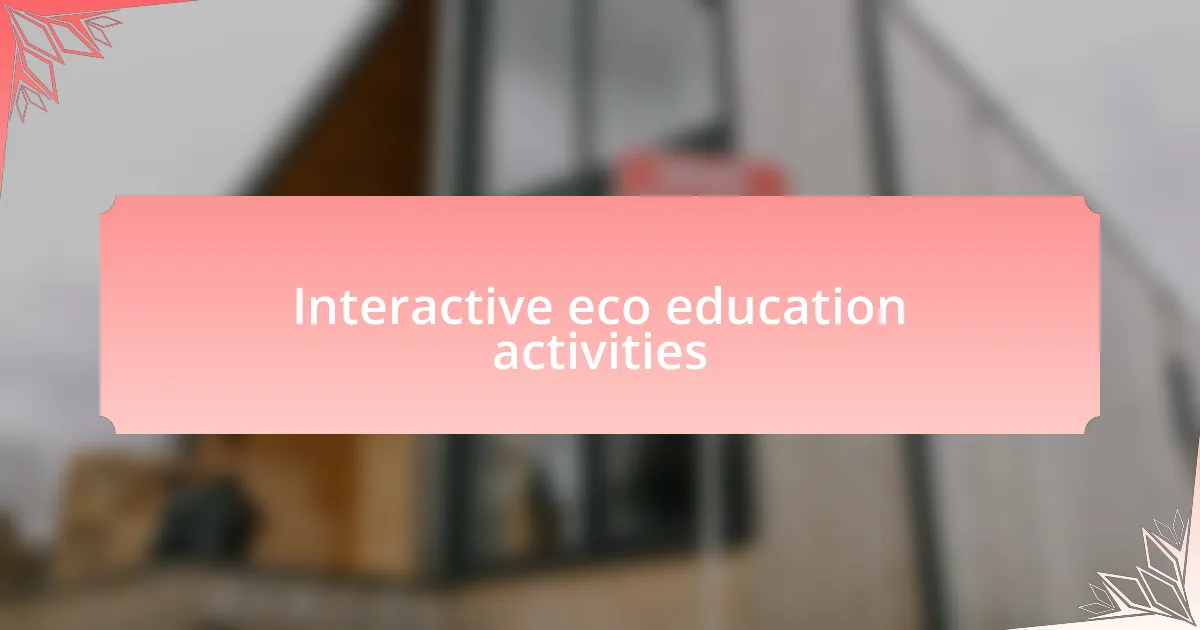
Interactive eco education activities
Incorporating interactive activities into eco-education keeps kids engaged and excited. One time, I set up a recycling relay race where children had to sort different materials quickly. Watching them enthusiastically compete while genuinely learning the importance of recycling highlighted how fun learning can be when it’s hands-on. Have you ever seen kids light up over sorting trash? It’s a transformative experience.
Gardening is another hands-on activity that I find incredibly effective. I remember introducing children to the concept of permaculture in a community garden. They not only planted seeds but also learned about the specific plants’ benefits to the ecosystem. Sharing the joy of harvesting fresh vegetables together created a sense of accomplishment and a deeper understanding of sustainability. Isn’t it fascinating how plants can bridge the gap between education and real-life applications?
Field trips to local environmental centers or wildlife reserves provide immersive learning experiences. During one trip, the kids participated in a birdwatching activity, discovering various species and their habitats. Observing their excitement as they spotted a rare bird made me realize how impactful these experiences can be in fostering a connection with nature. Don’t you think these memories will stay with them long after they leave the classroom?
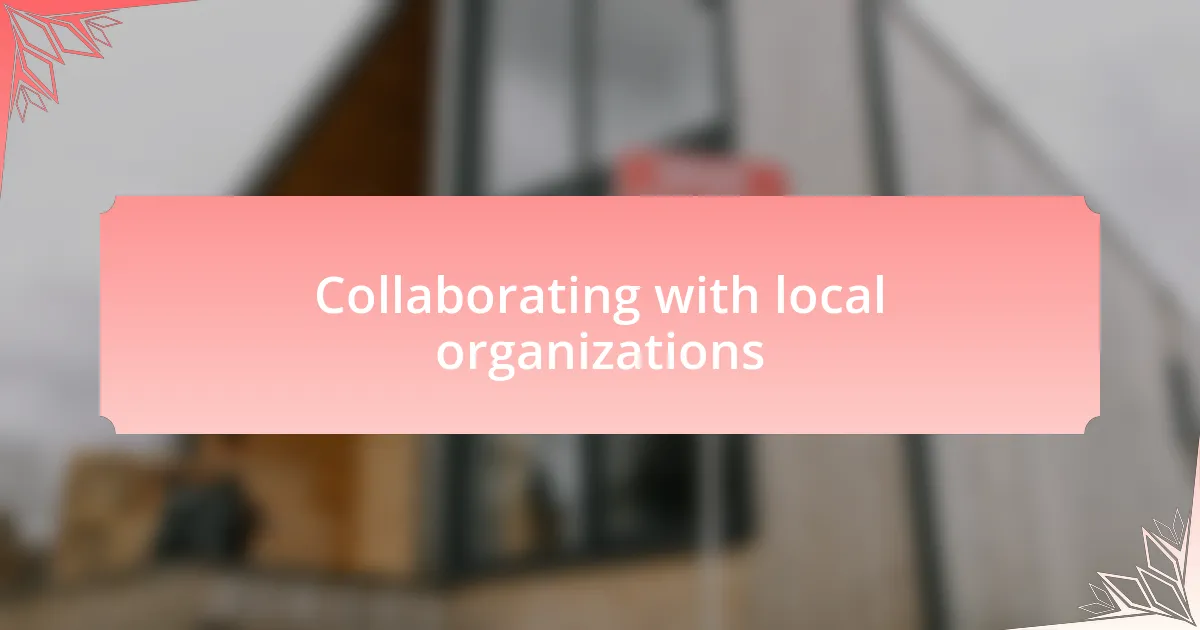
Collaborating with local organizations
Collaborating with local organizations can significantly enhance eco-education for kids. My experience partnering with a local wildlife rehabilitation center was eye-opening. They offered workshops where children could interact directly with rescued animals and learn about their habitats. It’s incredible to see their eyes widen in wonder as they realize these animals need our help. How often do we get the chance to spark compassion in young minds through direct connection?
I also remember teaming up with a community art group to create environmentally themed murals. Children contributed ideas and painted scenes depicting local wildlife and ecosystems. Watching them work together to beautify a public space was truly heartwarming. It made me think: how can creativity and environmental awareness go hand in hand? Engaging with local organizations like this not only reinforces learning but also fosters a sense of community pride among participants.
One partnership I found particularly rewarding was with a local university’s environmental science department. Students led workshops and interactive science experiments that opened up a whole new world for the kids. I still remember one young boy’s face lighting up as he saw a chemical reaction unfold right before his eyes. Doesn’t it make you wonder how powerful hands-on learning can be when it’s guided by passionate experts? Collaborations like these create lasting memories and connections to the environment that can shape attitudes for a lifetime.
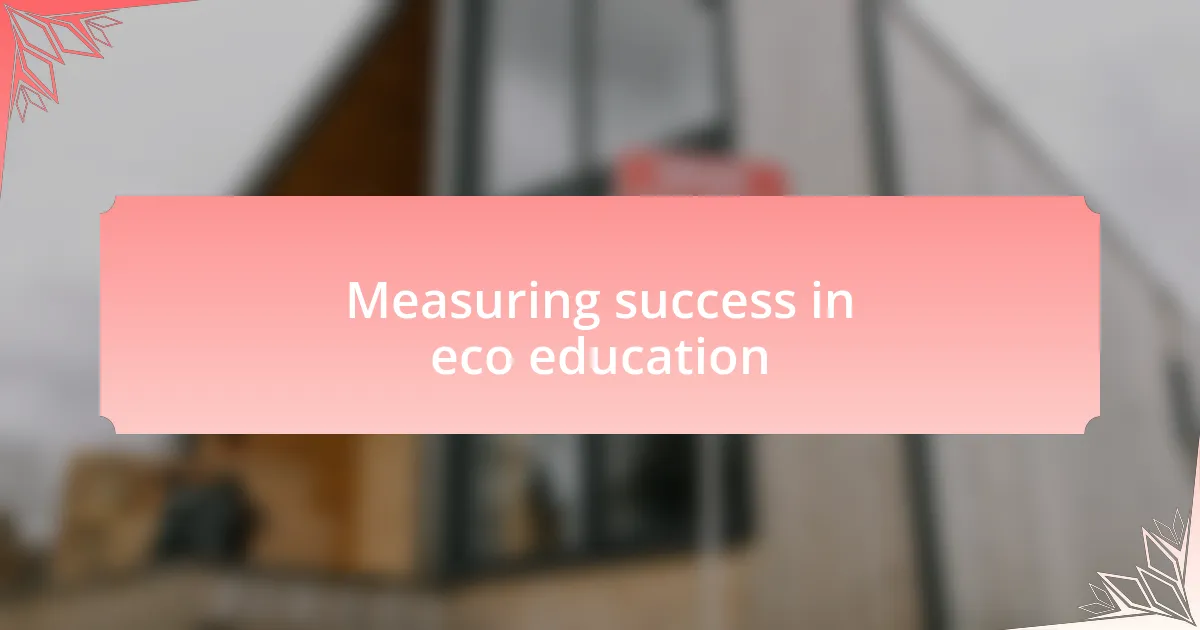
Measuring success in eco education
Measuring success in eco-education can often feel abstract, but I believe it’s about observing genuine shifts in children’s attitudes and behaviors. When we conducted a simple activity where kids tracked their recycling habits over a month, I noticed a few of them starting to educate their parents about it. It’s those “Aha!” moments that truly reflect how engaged they are. Have you ever seen a child passionately explain why we should reduce plastic use? That’s a sign we’re making an impact.
Additionally, I find the emotional engagement of the kids to be a vital indicator of success. During a community gardening event, I remember one little girl, who was initially shy, gradually opening up as she learned about composting. By the end of the day, she was enthusiastically sharing her newfound knowledge with her peers. Isn’t it fascinating how hands-on experiences can boost confidence? When children leave an eco-education session feeling empowered, that’s a measurable win.
The ultimate measure can also be the longevity of these environmental lessons in their lives. I still keep in touch with a couple of former students who, years later, actively participate in local beach clean-ups. Their ongoing commitment speaks volumes about the effectiveness of our eco-education efforts. Isn’t it incredible to think that the seeds of awareness we plant today could grow into lifelong stewardship?